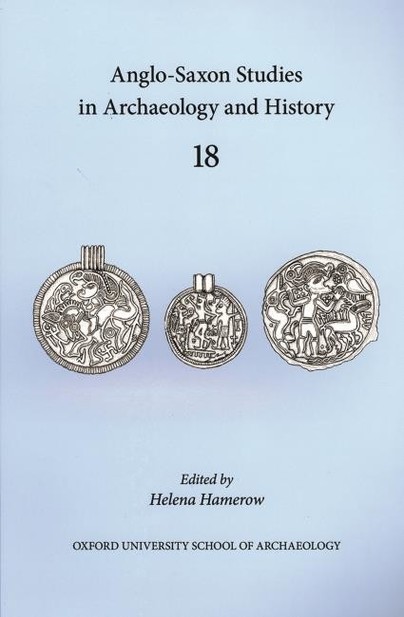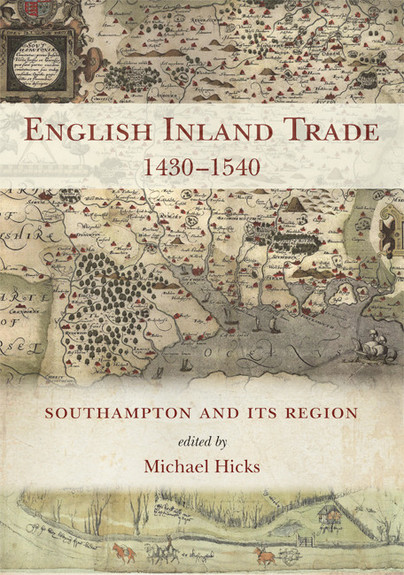
Format: Hardback
Pages: 184
ISBN: 9781782978244
Pub Date: 01 May 2015
Illustrations: b/w and colour illus.
Description:
The Southampton brokage books are the best source for English inland trade before modern times . Internal trade always matched overseas trade. Between 1430 and 1540 the brokage series records all departures through Southampton’s Bargate, the owner, carter, commodity, quantity, destination and date, and many deliveries too.
Twelve such years make up the database that illuminates Southampton’s trade with its extensive region at the time when the city was at its most important as the principal point of access to England for the exotic spices and dyestuffs imported by the Genoese. If Southampton’s international traffic was particularly important, the town’s commerce was representative also of the commonplace trade that occurred throughout England. Seventeen papers investigate Southampton’s interaction with Salisbury, London, Winchester, and many other places, long-term trends and short-term fluctuations. The rise and decline of the Italian trade, the dominance of Salisbury and emergence of Jack of Newbury, the recycling of wealth and metals from the dissolved monasteries all feature here. Underpinning the book are 32 computer-generated maps and numerous tables, charts, and graphs, with guidance provided as to how best to exploit and extend this remarkable resource.An accompanying web-mounted database (http://www.overlandtrade.org) enables the changing commerce to be mapped and visualised through maps and trade to be tracked week by week and over a century. Together the book and database provide a unique resource for Southampton, its trading partners, traders and carters, freight traffic and the genealogies of the middling sort.

Format: Hardback
ISBN: 9781782978282
Pub Date: 12 Mar 2015
Series: British Historic Towns Atlas
Description:
This atlas is the definitive account in maps and words of the historic royal towns of Windsor and Eton. There has never been an account of the history of Eton town, and although Windsor Castle has been much studied, the last historical account of the town of Windsor was published as long ago as 1858.The atlas contains high-quality and original maps of the two towns at key periods between the twelfth and nineteenth centuries.
At the heart of the atlas lies a detailed and minutely researched map showing all the major medieval and post-medieval features in the context of a large-scale map of the towns around 1870, using Ordnance Survey maps as a source. The substantial introduction to the history of these distinctive towns charts their development over eight centuries. The atlas is presented as a large-format, high-quality A3 folder, with maps and illustrations printed at A2, allowing clear detail to be seen.All the buildings, historic sites and streets named on the maps are comprehensively documented in a detailed gazetteer, covering the history of the sites and the many sources used in compiling the maps. The value of the atlas is enhanced by the inclusion of numerous colour illustrations, including early maps and views of the towns, many of them previously unknown.For the first time, new research by historians, archaeologists and cartographers has been brought together to compile this unique and original portfolio.
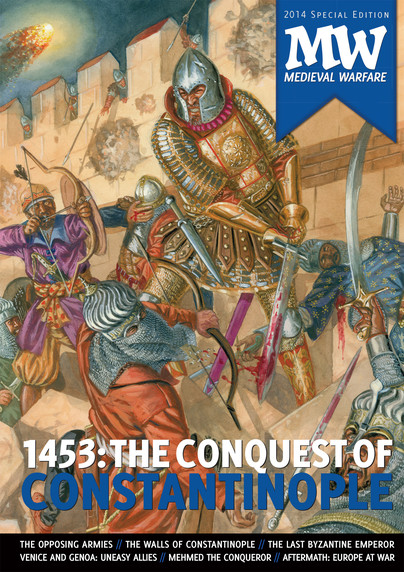
Format: Paperback
Pages: 80
ISBN: 9789490258108
Pub Date: 28 Feb 2015
Illustrations: 95
Description:
The 2014 Medieval Warfare Special issue is entirely dedicated - all 84 pages - to the Fall of Constantinople in 1453. It's like a normal issue, except it'll have more pages, more articles, more maps and more illustrations! Medieval Warfare Special 2014: 1453 - The Conquest of Constantinople with: - Eugenia Russel, Historical introduction – the destruction of the Oikoumeni - Kenneth Cline, Constantine XI – no room to maneuver - Murat Özveri, Mehmed ‘the Conqueror’ – A sultan of paradoxes - Nicola Bergamo, Venice, Genoa and Byzantium – difficult ‘trio' - Konstantin Nossov, The walls of Constantinople - Stephen Bennett & Nils Visser, The Conquest of Constantinople - Murray Dahm, Fallout – Contemporary reactions to the loss of Constantinople - Lukasz Rozycki, The fall of the Old World through the eyes of the “Polish janissary” - Raffaele D’Amato, The last defenders – the Roman army - Vassilis Pergalias, The final opponents – the Ottoman army - Ben Sheppard, Aftermath
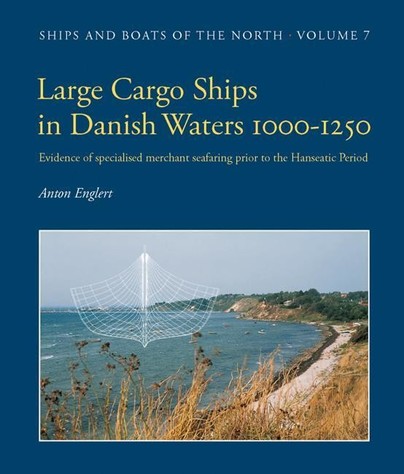
Format: Hardback
Pages: 378
ISBN: 9788785180537
Pub Date: 22 Jan 2015
Series: Ships & Boats of the North
Illustrations: 240 illustrations
Description:
“A wealthy man in Denmark, citizen of the town of Schleswig, built a large ship at great expense. And the king of the country decided to join company and take part in the profits. And after he had made good half of the costs, he owned a corresponding part of the ship …”The medieval Hanseatic merchants are famous for their maritime trade network, which extended across Northern Europe from the 13th century onward.
The rare quote above sheds light on a less known period, beginning in the late Viking Age, when large, elegant cargo ships were built and sailed across the sea by Scandinavian merchants.This volume presents the earliest archaeological evidence for specialised merchant seafaring in Danish waters. The cargo ship-finds of Eltang Vig, Lynæs, Karschau and Haderslev are explored in detail in order to illuminate the technology and style of a dynamic age of maritime enterprise and cultural transformation.
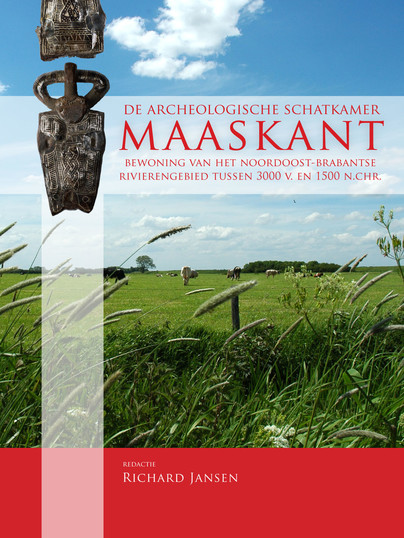
Format: Paperback
Pages: 468
ISBN: 9789088902253
Pub Date: 31 Dec 2014
Description:
This books present papers on the archaeology of the region between the river Meuse and the city of Oss (Netherlands), locally known as the "Maaskant". The papers presented in this volume discuss the period from 3000 BC until 1500 AD. The wealth of archaeological data from this region indicated this part of the Netherlands was inhabited by early farmers already 5000 years ago.
The strategic location near the river did not only provide fertile grounds but also formed an intersection in transport and communication routes.

Format: Hardback
Pages: 964
ISBN: 9781891271205
Pub Date: 08 Dec 2014
Imprint: Celtic Studies Publications
Description:
What awaits us beyond the grave is perhaps the fundamental human mystery. Visionary accounts of the afterlife are attested long before the Common Era, and loomed large in the imaginative universe of early Christianity. The medieval Irish inherited and further transformed this tradition, producing vivid eschatological narratives which had a profound impact throughout Europe as well as being works of remarkable literary and spiritual power in their own right.
Under the headings ‘Soul and Body’, ‘The Seven Heavens’, ‘The Next World’, and ‘The Judgement and its Signs’, this book presents critical editions, with translation and commentary, of 26 eschatological texts from the Old, Middle, and Early Modern Irish periods, together with related material in Latin and Old English. Some of these works are here edited for the first time. Extended essays survey Irish eschatological literature a whole, and place it in its wider context; and the volume concludes with a comprehensive handlist of Irish eschatological compositions. This book consists of two volumes.
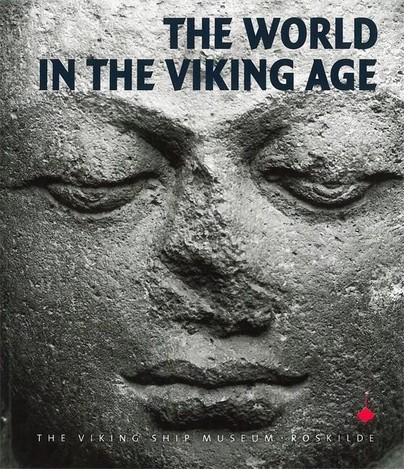
Format: Paperback
Pages: 140
ISBN: 9788785180704
Pub Date: 28 Apr 2014
Description:
The Viking Age was ignited by the art of building seaworthy sailing ships and the skills to sail them on the open sea. The growth in seafaring, trade, piracy, and exploration that began to gather momentum during the 8th century CE was not limited to Europe’s northern seas, however. Ships, laden with cargo and with seafarers who met foreign cultures, created unexpected connections between people from the Arctic Circle to the oceans south of the equator.
Travel accounts have handed down glimpses of these voyages to the present day. However, it is archaeological discoveries in particular which uncover the story of Viking-Age seafaring and voyages of exploration. The World in the Viking Age reveals a global history concerning ships, people and objects on the move. It is a story that challenges entrenched ideas about the past and present, and the skills and opportunities of previous generations.

Format: Paperback
Pages: 120
ISBN: 9781782972150
Pub Date: 23 Apr 2014
Illustrations: b/w and col. illustrations
Description:
The analysis of silk is a fascinating topic for research in itself but here, focusing on the 9th and 10th centuries, Marianne Vedeler takes a closer look at the trade routes and the organization of production, trade and consumption of silk during the Viking Age. Beginning with a presentation of the silk finds in the Oseberg burial, the richest Viking burial find ever discovered, the other silk finds from high status graves in Scandinavia are discussed along with an introduction to the techniques used to produce raw silk and fabrics. Later chapters concentrate on trade and exchange, considering the role of silk items both as trade objects and precious gifts, and in the light of coin finds.
The main trade routes of silk to Scandinavia along the Russian rivers, and comparable Russian finds are described and the production and regulation of silk in Persia, early Islamic production areas and the Byzantine Empire discussed. The final chapter considers silk as a social actor in various contexts in Viking societies compared to the Christian west.

Format: Paperback
Pages: 152
ISBN: 9781909990005
Pub Date: 01 Apr 2014
Series: Scottish Burgh Survey
Description:
Situated in what now seems a remote corner of south-west Scotland, Wigtown was once an important county town. With its harbour and location at the lowest fording point of the River Cree, Wigtown was at one time part of a major network of land and sea routes, including a pilgrim route to Whithorn. The layout of the town is notable for its large market square, a reflection of its importance in the cattle trade in the medieval period.
The town achieved burgh status in the thirteenth century, by which time it was an important trading centre, and the present arrangement of streets and burgage plots dates to this time. Today the principal access route is from the north, rather than through the East and West Ports which controlled access to the great market place. The burgh arms depict a three-masted sailing ship, demonstrating the importance placed on its maritime trade. This book examines both the town’s political history, as it passed between the earldoms of Wigtown and Douglas, and its economic history, as it competed with Whithorn, before its eventual decline in the later nineteenth century. The authors use the surviving buildings to examine the development of the town from the medieval to the modern period. This book is part of the Scottish Burgh Survey – a series funded by Historic Scotland designed to identify the archaeological potential of Scotland’s historic towns.
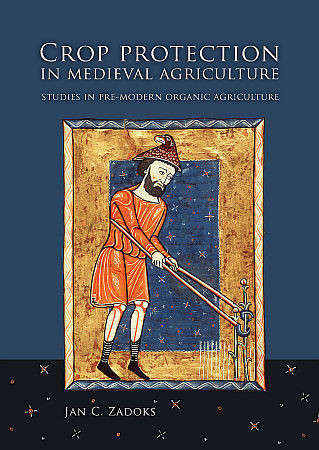
Format: Paperback
Pages: 330
ISBN: 9789088901874
Pub Date: 04 Dec 2013
Description:
Mediterranean and West European pre-modern agriculture (agriculture before 1600) was by necessity ‘organic agriculture’. Crop protection is part and parcel of this agriculture, with weed control in the forefront.Crop protection is embedded in the medieval agronomy text books but specialised sections do occur.
Weeds, insects and diseases are described but identification in modern terms is not easy. The pre-modern ‘Crop Portfolio’ is well filled, certainly in the Mediterranean area. The medieval ‘Pest Portfolio’ differs from the modern one because agriculture then was a Low External Input Agriculture, and because the proportion of cultivated to non-cultivated land was drastically lower than today. The pre-modern ‘Control Portfolio’ is surprisingly rich, both in preventive and interventive measures. Prevention was by risk management, intensive tillage, and careful storage. Intervention was mechanical and chemical. Chemical intervention used natural substances such as sulphur, pitch, and ‘botanicals’. Some fifty plant species are mentioned in a crop protection context.Though application methods look rather modern they are typically low-tech. Among them are seed disinfection, spraying, dusting, fumigation, grease banding, wound care, and hand-picking but also scarification, now outdated. The reality of pest outbreaks and other damages is explored as to frequency, intensity, and extent. Information on the practical use of the recommended treatments is scanty. If applied, their effectiveness remains enigmatic.Three medieval agronomists are at the heart of this book, but historical developments in crop protection from early Punic, Greek, and Roman authors to the first modern author are outlined. The readership of these writers was the privileged class of landowners but hints pointing to the exchange of ideas between them and the common peasant were found. Consideration is given to the pre-modern reasoning in matters of crop protection. Comparison of pre-modern crop protection and its counterpart in modern organic agriculture is difficult because of drastic changes in the relation between crop areas and non-crop areas, and because of the great difference in yield levels then and now, with several associated differences.About the author: Jan C. Zadoks, born in Amsterdam, 1929, studied biology at the University of Amsterdam, graduating in 1957. He received his Ph.D. from the University of Amsterdam in 1961, with honours, and joined the Wageningen Agricultural University as a plant pathologist. He developed various courses in the area of plant disease epidemiology.
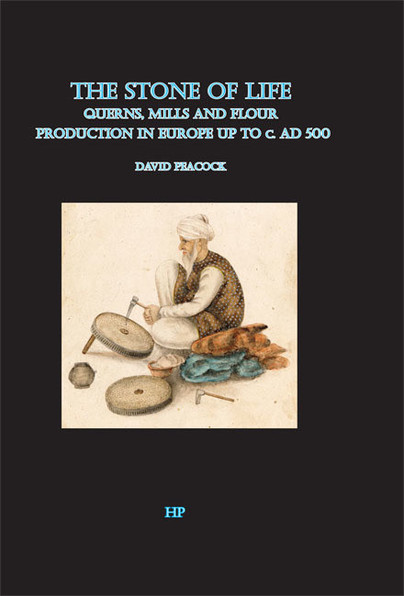
Format: Hardback
Pages: 220
ISBN: 9780992633608
Pub Date: 30 Nov 2013
Imprint: The Highfield Press
Description:
This book is about the archaeology querns and mills, simple stone instruments which are vital to survival in a society which adopts bread as its staple. They become the ‘stones of life’, an essential ingredient in the subsistence strategy of settled agriculturalists. It might be expected that as querns and mills are commonplace in archaeology, they would be key artefacts, studied exhaustively.
Alas, this is far from the case. They have been woefully neglected, although in the last decade there has been burgeoning interest throughout much of Europe and because of this, it is timely to survey the subject, adopting a broad viewpoint. A study on this scale has not been attempted since the late nineteenth century when Bennett and Elton published their magisterial work on the History of corn milling.The author is Emeritus Professor of Archaeology at the University of Southampton and a Fellow of the Societies of Antiquaries. He was awarded the Kenyon Medal of the British Academy in 2011 and the Pommerance Medal of the Archaeological Institute of America in 2012. He has had a lifelong interest in querns and mills on which he has published widely. His work includes the discovery of key mill quarries in the Mediterranean – Orvieto in Umbria and Mulargia in Sardinia, while in Britain the Lodsworth quarries remain the only ones to be found by a deliberate search strategy. The reader will be grateful to Chris Green, also a Fellow of the Society of Antiquaries, for the clear and elegant illustrations which enhance the book and elucidate the text.
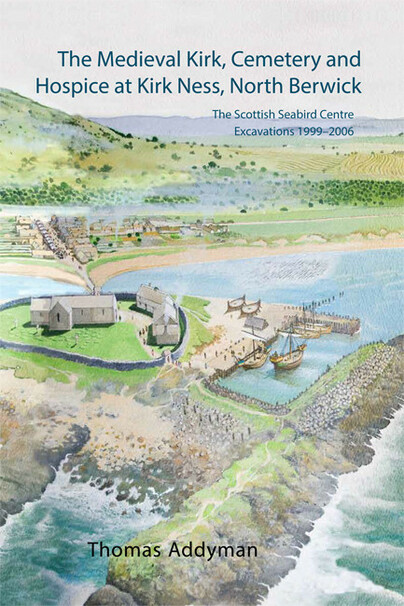
Format: Hardback
Pages: 256
ISBN: 9781842176634
Pub Date: 13 Nov 2013
Illustrations: b/w & col. illus
Description:
Between 1999-2006 Addyman Archaeology carried out extensive archaeological excavations on the peninsular site of Kirk Ness, North Berwick, during the building, landscaping and extension of the Scottish Seabird Centre. This book presents the results of these works but its scope is much broader. Against the background of important new discoveries made at the site it brings together and re-examines all the evidence for early North Berwick – archaeological, historical, documentary, pictorial and cartographic – and includes much previously unpublished material.
An essential new resource, it opens a fascinating window on the history of the ancient burgh. Kirk Ness is well known as the site of the medieval church of the parish and later royal burgh of North Berwick but it has long been suggested that it was also a centre of early Christian activity. The dedication of the church to St Andrew was speculatively linked to the translation of the Saint's relics to St Andrews in Fife in the 8th century. An early medieval component of the site was indeed confirmed by the excavation, with structural remains, individual finds and an important new series of radiocarbon dates. Occupation of a domestic character may possibly reflect a monastic community associated with an early church. Individual finds included stone tools, lead objects, ceramic material and a faunal assemblage that included bones of butchered seals, fish and seabirds such as the now-extinct Great Auk. The site continued in use as the medieval and early post-medieval parish and burgh church of St Andrew. In this period Kirk Ness and its harbour was an important staging point for pilgrims on route to the shrine of St Andrew in Fife. Domestic occupation discovered in the excavations is likely to be associated with a pilgrims’ hospice, also suggested in historical sources. This publication also provides a new analysis of the church ruin and an account of the major unpublished excavation of the site carried out in 1951-52 by the scholar and antiquary Dr James Richardson, Scotland's first Inspector of Ancient Monuments and resident of North Berwick. The excavations also revealed areas of the cemetery associated with the church, dating to the 12th–17th centuries, where inhumations presented notable contrasts in burial practice. Osteological study shed much light upon the health and demographics of North Berwick’s early population and identified one individual who met with a particularly violent death.

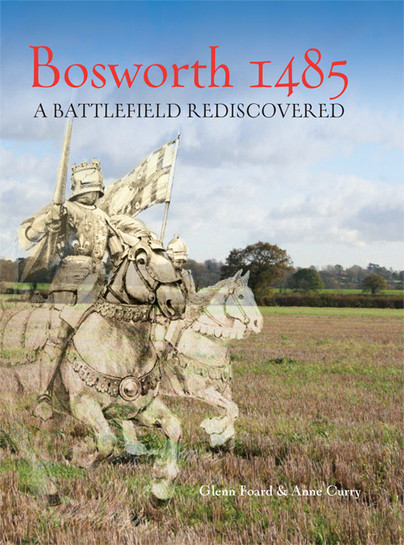
Pages: 264
ISBN: 9781782971733
Pub Date: 22 Aug 2013
Illustrations: colour throughout
Pages: 240
ISBN: 9781789258776
Pub Date: 25 Jun 2022
Illustrations: Colour
Description:
Bosworth stands alongside Naseby and Hastings as one of the three most iconic battles ever fought on English soil. The action on 22 August 1485 brought to an end the dynastic struggle known as the Wars of the Roses and heralded the dawn of the Tudor dynasty. However, Bosworth was also the most famous lost battlefield in England.
Between 2005 and 2010, the techniques of battlefield archaeology were used in a major research programme to locate the site. Bosworth 1485: A Battlefield Rediscovered is the result. Using data from historical documents, landscape archaeology, metal detecting survey, ballistics and scientific analysis, the volume explores each aspect of the investigation – from the size of the armies, their weaponry, and the battlefield terrain to exciting new evidence of the early use of artillery – in order to identify where and how the fighting took place. Bosworth 1485 provides a fascinating and intricately researched new perspective on the event which, perhaps more than any other, marked the transition between medieval and early modern England.
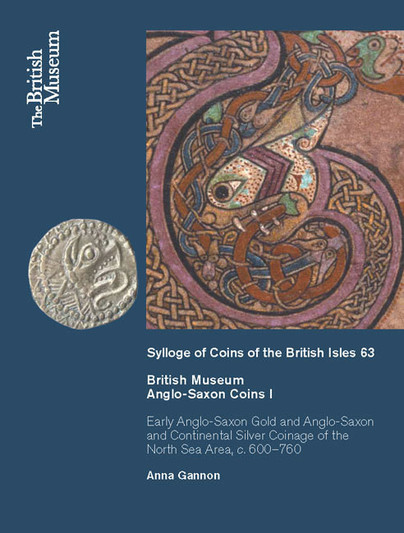
Format: Hardback
Pages: 304
ISBN: 9780714118239
Pub Date: 05 Aug 2013
Description:
This volume is dedicated to the British Museum’s collection of early Anglo-Saxon gold coinage as well as the Anglo-Saxon and Continental silver coinage of the North Sea area, dating from the early seventh to the mid-eighth centuries. This was the coinage which circulated during the age of Bede, the Lindisfarne Gospels and Sutton Hoo, and which is widely celebrated for its historical significance and artistic accomplishment. Both these features are well illustrated in this volume by more than 850 coins, which together form one of the largest, oldest and most representative collections of this complex coinage.
The last catalogue of this part of the British Museum’s collection was published in 1887 and since then the collection has more than tripled in size. This new catalogue includes comprehensive coverage of all new acquisitions, among them material from several significant hoards, as well as full details on the provenance and identification of individual coins. A major introduction sets the coins in context and reassesses their classification. New metallurgical analyses of the gold coinage and authoritative interpretation of the results, as well as a survey of the history of the collection, constitute further valuable supplements to the catalogue.
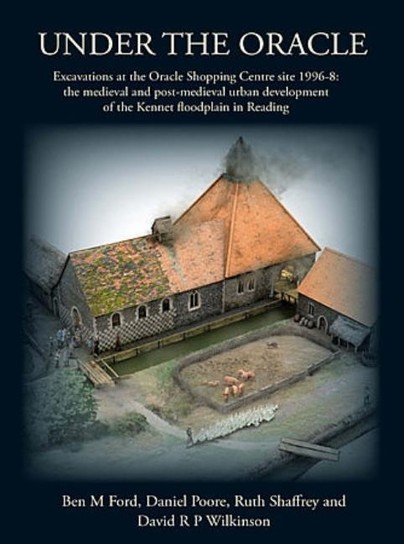
Format: Hardback
Pages: 340
ISBN: 9781905905270
Pub Date: 01 Apr 2013
Series: Thames Valley Landscapes Monograph
Description:
Excavations carried out by Oxford Archaeology in advance of the building of the Oracle shopping centre revealed a long sequence of development of the Kennet floodplain at Reading. This volume reports on the substantial evidence recovered for medieval and post-medieval water management, milling at the Minster Mill and St Giles Mill, the tanning, leather working and dyeing industries, and an unusual building interpreted as the 12th- to 13th-century cookhouse of Reading Abbey. The stories of two well-known Reading sites, the Oracle Workhouse and the Yield Hall, are followed from the medieval period up to the 19th century.
Substantial specialist reports include pottery, glass, leatherworking, dendrochronology and clay pipes.

















